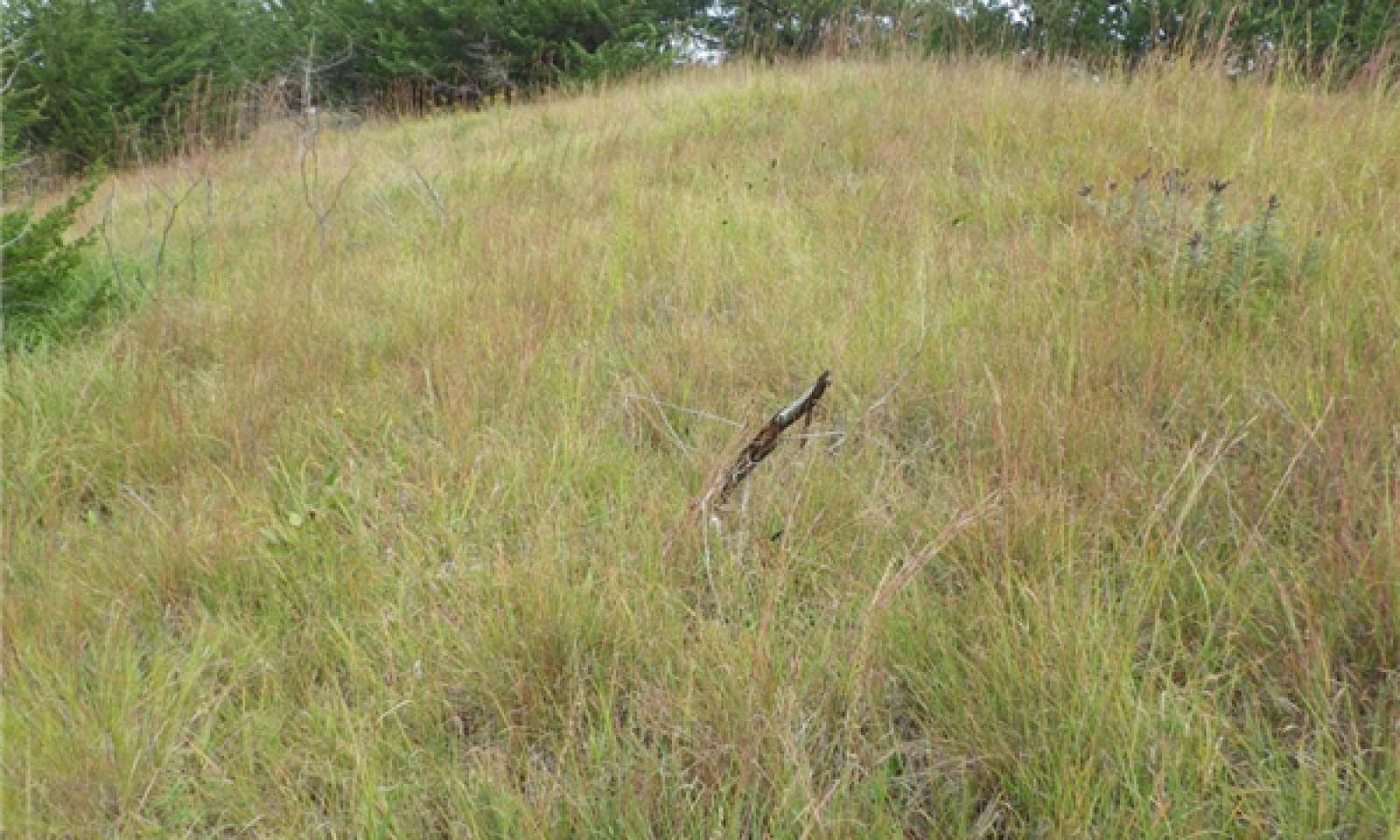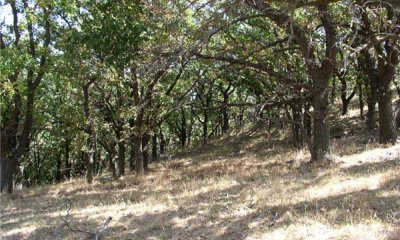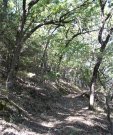
Loess Breaks
Scenario model
Current ecosystem state
Select a state
Management practices/drivers
Select a transition or restoration pathway
-
Transition T1A
Reduced native grass competitiveness due to excessive defoliation intensity and frequency or drought
More details -
Transition T1B
Oak and cedar encroachment leading to woody plant dominance
More details -
Restoration pathway R2A
Restoration inputs; reduced invasive grass competitiveness allows for natives to dominant site
More details -
Transition T2A
Oak and cedar encroachment leading to woody plant dominance
More details -
Restoration pathway R3A
Woody species removal; restoration of warm season native grasses
More details -
No transition or restoration pathway between the selected states has been described
Target ecosystem state
Select a state
Description
This state comprises the communities within the range of natural variability under historic conditions and disturbance regimes. Patterns created by wildlife use and fire would have created a mosaic of communities across the landscape; however, tall and/or mid warm-season grasses would remain dominant, with a subdominant contribution from native cool-season grasses, forbs, and shrubs. The cool-season contribution increases with latitude, with species such as needleandthread and green needlegrass becoming more prevalent northward.
Fire and bison herbivory were the dominant disturbance regimes that historically maintained the tallgrass dominance with a diverse forb component. Furthermore, bison grazing was closely linked to fire patterns as the animals preferred grazing burned areas offering lush regrowth devoid of decadence and of higher nutritive quality. Thus, historic plant communities were subjected to occasional burning and grazing, with substantial rest/recovery periods as the fuel load rebuilt to eventually start the process again. Fire return intervals of 3-4 years served to suppress woody species, particularly non-sprouting eastern redcedar. The degree to which observed conditions represent this state largely depends on how closely the management has mimicked these past disturbance effects.
Submodel
Description
This state can manifest three ways: 1) the appearance of introduced cool-season grasses, 2) the expansion of deciduous shrubs and/or trees, or 3) some combination of these. Kentucky bluegrass and smooth brome are the primary cool-season grass invaders in this region, commonly found in roadsides, disturbed areas, and pastures intentionally seeded for cool-season forage. Management practices and/or environmental conditions that are not favorable to native grass vigor may allow introduced grasses to invade the site thereby decreasing native diversity and abundance, particularly of forbs.
In the absence of the historic fire regime, woody deciduous species may also expand to become an influential component of the community. The invasive component tends to have very high reslience, is extremely difficult to eradicate, and what might be considered a new "contemporary" range of natural variability is seen as competition between the native grasses and introduced/woody species for space and resources.
Submodel
Description
Woody species have established a significantly closed canopy that influences the herbaceous understory through processes such as stemflow, litterfall, and variable understory insolation, creating more heterogenous resource distribution relative to historic grassland conditions. Also, the precipitation gradient produces changes in both overstory and understory species composition seen as increased eastern deciduous forest influence mixing with bur oak southeasterly in MLRA.
Submodel
Mechanism
In the presence of introduced cool-season grasses, environmental conditions and/or management that reduces native vigor and stand resilience, and frees up resources (space, sunlight, nutrients, water) will allow for colonization of Kentucky bluegrass and smooth brome. Likewise, similar processes may also allow for deciduous woody shrubs and trees such as smooth sumac, roughleaf dogwood, and Siberian elm to expand.
Constraints to recovery
Reduced native competitiveness allows for introduced grass colonization and expansion
Mechanism
The presence of an invasion source coupled with fire exclusion allows woody species to expand and establish within the herbaceous stand. This typically begins near woody draws and accelerates outward as propagules increase. Lack of intervening action allows woody expansion to continue, and tree sizes to increase. Trees will eventually modify site function in ways that promote further encroachment such as rainfall interception and stemflow, heavy leaf litter, and shading of the herbaceous understory.
Mechanism
Eradication of introduced cool-season grasses from this site will require long-term, targeted management efforts to create an adverse environment during the spring and late fall when bluegrass
and brome are most actively growing, with favorable conditions during the summer to promote native warm-season species. Targeted practices such as prescribed burning, flash grazing, and herbicide are often employed at strategic times of the year to set back undesirable species. The combination of practices should strive to mimic the historic disturbance regimes to which the desirable native species are best adapted.
Mechanism
The presence of an invasion source coupled with fire exclusion allows woody species to expand and establish within the herbaceous stand. This typically begins near woody draws and accelerates outward as propagules increase. Lack of intervening action allows woody expansion to continue, and tree sizes to increase. Trees will eventually modify site function in ways that promote further encroachment such as rainfall interception and stemflow, heavy leaf litter, and shading of the herbaceous understory.
Mechanism
With deciduous dominance, taller trees, thicker bark, and reduced understory ladder fuels have created a woodland community virtually invulnerable to fire. Overstory thinning/removal will require labor-intensive mechanical and/or chemical methods on difficult terrain. Solid cedar stands may be able to carry an effective fire, but this will steep slopes largely denuded and exposed thereby requiring additional mitigative actions to preserve site stability.
The outcomes of restoration activities can vary, depending heavily on both the present understory and the seedbank, and may instead result in a rapid increase of sprouting species such as roughleaf dogwood and/or smooth sumac which will require further efforts.
Model keys
Briefcase
Add ecological sites and Major Land Resource Areas to your briefcase by clicking on the briefcase (![]() ) icon wherever it occurs. Drag and drop items to reorder. Cookies are used to store briefcase items between browsing sessions. Because of this, the number of items that can be added to your briefcase is limited, and briefcase items added on one device and browser cannot be accessed from another device or browser. Users who do not wish to place cookies on their devices should not use the briefcase tool. Briefcase cookies serve no other purpose than described here and are deleted whenever browsing history is cleared.
) icon wherever it occurs. Drag and drop items to reorder. Cookies are used to store briefcase items between browsing sessions. Because of this, the number of items that can be added to your briefcase is limited, and briefcase items added on one device and browser cannot be accessed from another device or browser. Users who do not wish to place cookies on their devices should not use the briefcase tool. Briefcase cookies serve no other purpose than described here and are deleted whenever browsing history is cleared.
Ecological sites
Major Land Resource Areas
The Ecosystem Dynamics Interpretive Tool is an information system framework developed by the USDA-ARS Jornada Experimental Range, USDA Natural Resources Conservation Service, and New Mexico State University.






